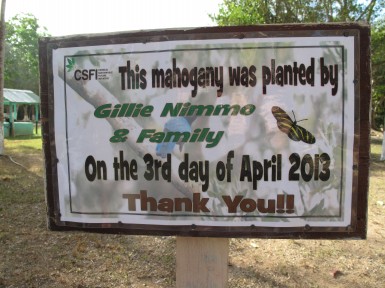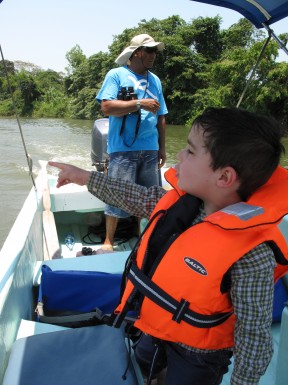By Richard Nimmo, Managing Director of Blue Ventures Expeditions
I have just returned from my annual trip to Belize to work with our team there to review health and safety policies, plan new projects, and meet partners and friends of Blue Ventures.
This year, my visit also took in some tourism for a week after my work duties were complete, and for the first time, my four-year-old son Gillie, joined me for an overseas trip.
Blue Ventures has run marine conservation expeditions for 10 years, beginning in Madagascar in 2003 and adding Belize as an expedition site in 2010. Our expeditions contribute to our research efforts, and we have demonstrated that tourism can play a major part in conservation by improving awareness as well as providing manpower and funding for projects. We work tirelessly to encourage responsible and ethical tourism, develop and support good practice, and promote the best that tourism can offer. This blog is about the tourism experience that I had during my trip to Belize and will hopefully highlight this exciting but lesser known destination, and some of the great experiences that tourists can have in Belize.
The lead-up to the trip was full of excitement for my son, weeks of the question “when are we going to Belize?” did become a little wearing and I was worried that the reality would not match his anticipation. I needn’t have been concerned as Belize delivered a tourism experience well beyond my expectations.
Our trip took in three destinations: Crooked Tree, Sarteneja, and Maya Beach near Placencia.
Crooked Tree is a village in northern Belize district, only 30 minutes drive from the international airport, surrounded by a wildlife sanctuary with a lagoon full of bird life at its centre. As we struggled to recover from jet-lag, our efforts to look around the wildlife sanctuary were limited but the viewing deck and views from our cabana at Crooked Tree Lodge gave us ample opportunity to see hundreds of birds; parrots, waders, birds of prey, vultures and kingfishers all entertained us during our stay but the huge Jabiru Stork was the highlight.
From Crooked Tree, we took the bone-shuddering Northern Highway through Orange Walk and Little Belize to Sarteneja. The road meanders through farm country where my son mistook Mennonites for cowboys, and sugar cane fields dominate the landscape.
Sarteneja is where Blue Ventures’ expeditions begin, and our home in Belize since 2010. Sarteneja is a quiet fishing village in Corozal District, it is relatively remote due to the lure of the sea and Cayes to the south and the poor roads, but nonetheless the area has tourism opportunities, great hospitality and much to offer.
On the outskirts of Sarteneja is the Shipstern Nature Reserve where we spent two nights staying in the guesthouse that was built in 2012. The guesthouse is clean and comfortable, the food is great, and most importantly it is right next to the forest. Morning bird walks can be conducted straight from the guesthouse front door, and the observation tower, which gives views from above the tree canopy, is just 50 metres away.
Tourism revenue helps to finance this reserve and also the co-management of other protected areas in Belize that Shipstern work in. The relative isolation of Sarteneja limits the numbers of tourists to the Shipstern Nature Reserve, a shame for the reserve and also for tourists missing out on a great wildlife experience. The wonderful team of rangers and guides at Shipstern, led by Heron Moreno, offer an array of interesting walks and tours and some exciting trips such as the night tour of the lagoon, spotting Morelet’s Crocodiles by lamplight from a canoe and climbing into bat caves as the winged mammals zipped past our heads. Both father and son were enthralled.
One of the projects that the team at Shipstern are focusing on is planting tree species that are affected by illegal logging. The reserve has a nursery for mahogany and they plant within the reserve and at schools to raise awareness of the issue. My son had the opportunity to plant one of the saplings and a plaque now announces his contribution to the reforestation.
From Shipstern we moved to Sarteneja, where we stayed with a Belizean family in a homestay. Blue Ventures uses the Sarteneja Homestay Association to accommodate all of our volunteers during the two weeks that they spend in the village. Homestays offer an authentic Belizean family experience, great food, good company and most importantly allow us to direct much needed income directly into the pockets of community members.
I stayed, for a second time, in the home of Ivett and Ricky Verde and their four sons, and they greeted us like long-lost family members. Gillie felt so at home after three days that he joined them for a family birthday party and had to be dragged away, protesting that it wasn’t late, at the end of the night.
I think that homestays are one of the best ways to experience the life and culture of a country, and when they are well run they are also comfortable and affordable. They also have huge economic benefits to communities. In Belize, Blue Ventures has been responsible for nearly 3,000 tourist nights in homestays and over US$50,000 of revenue for the Sarteneja Homestay Association. The association is part of the Sarteneja Alliance for Conservation and Development (SACD) and is one of a number of alternative livelihood initiatives in the area. Homestays can be booked through Sarteneja Adventure Tours.
From Sarteneja we travelled south on the Northern Highway and then followed the Hummingbird Highway through the mountains and forests of Cayo District to Maya Beach in Stann Creek District. The highway deserves its poetic name and we delighted in the beautiful views, miles of emptiness and inviting roadside eateries. Regular emergency stops to avoid turtles, snakes and iguanas added to the excitement.
Maya Beach is a quiet stretch of the Placencia peninsula and we spent a week at the Maya Beach Hotel enjoying the sea, pool and great food. The restaurant at the hotel is very good and I was particularly pleased to see Lionfish on the specials menu there. Blue Ventures is working with partner NGOs, fishing cooperatives and fishers to deal with the problems associated with this invasive and voracious predator that has reached the Caribbean sea where it is reproducing at an alarming rate and extending its range. Our current focus is to work with fishing cooperatives to develop an export market for the fish as developing a new viable commercial export initiative would benefit Belizean fishers while reducing the population of this invasive and destructive species.
At Maya beach we watched Brown Pelicans fly past our balcony in huge numbers, Magnificent Frigate Birds swirl in the thermals above us, and heard raccoons scampering across our roof at night. When we encountered a dolphin on a sea kayak trip and a scorpion outside our room one night, our trip had officially become “the best holiday ever” in the life of a four-year-old.
On our penultimate day at Maya Beach, we took a boat trip south to Toledo District and Monkey River, where there are birds in abundance and Howler Monkeys live up to their name. En route we encountered Antillean Manatees (a subspecies of the West Indian Manatee) in the lagoon, munching on seagrass and creating plumes of silt with which we could identify their progress and easily anticipate their next visit to the surface.
On our last day, as we headed north on the Hummingbird Highway to the international airport, we stopped at Belize Zoo, the self-proclaimed “best little zoo in the world”. It was definitely worth the visit and is full of the wildlife highlights of Belize.
As we dropped off our rental car and walked towards the international airport, my son declared his wish never to leave Belize and at that moment I admit I was in full agreement.




